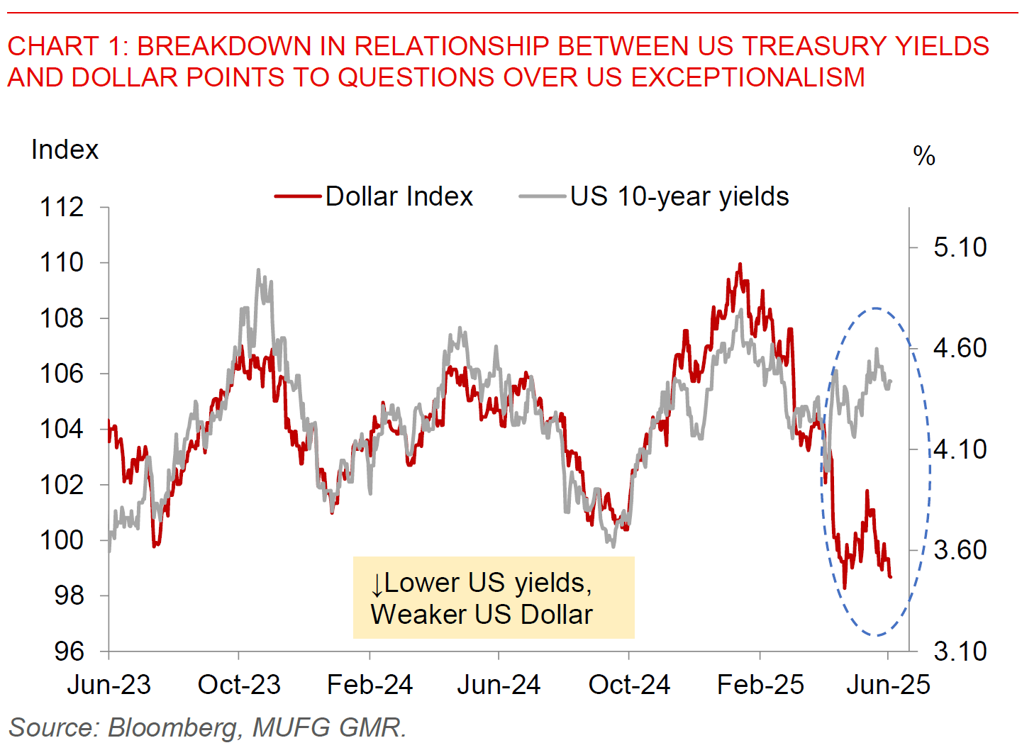Ahead Today
G3: US JOLTs Job Opening, US Durable Goods Orders
Asia: Caixin China PMI Manufacturing
Market Highlights
The US Dollar weakened and Asian currencies traded mixed at the start of the week. This may have been driven in part by higher policy uncertainty out of US and question marks around the current US-China tariff pause, with announcement of tariff hikes to 50% from 25% on steel and aluminum products by Trump, together with accusations from both US and China on violations of the Geneva trade détente. Meanwhile, US data was weak and pointed to a continued stagflationary environment, with US ISM Manufacturing declining to 48.5. Details showed new orders and employment remained in the contractionary zone while prices paid were elevated at 69.4. While the details were not as bad as the headline numbers suggest, given a decline in inventories and slight pickup in new orders, the bigger picture is still a negative supply shock for the US from tariffs compounded by significant policy uncertainty.
Taking a step back, the interesting part for markets has also been a continued breakdown in correlation between the US Dollar and US Treasuries, and also correspondingly how the Dollar has not benefited when US data surprises to the downside. In fact, alternative safe haven assets including gold and even some Asian bond markets have benefited during such risk-off periods looking at the price action, and the broader picture may still be questions over the extent of US exceptionalism.

Regional FX
Asian FX performance was mixed than the broad Dollar weakness suggested, with some underperformance in the Thai Baht and South Korean won, while USD/CNH remained flat at around 7.2054 following a climb to 7.22 levels earlier.
The key event for markets in Asia will be South Korea’s Presidential elections, and in particular between the two leading candidates – Lee Jae-myung of the Democractic Party of Korea, and Kim Moon-so of the People Power Party. Latest polls still point to a win by Lee Jae-myung of the DP as the most likely scenario, but the polls have pointed to a tightening race between these 2 candidates. While both candidates are generally supportive of fiscal easing, we note there will likely be a larger fiscal stimulus if Lee Jae-myung were to win. This is both because the DP is generally more supportive of fiscal expansion and bigger government, with Lee Jae-myung proposing an extra budget worth 1.2% of GDP to prop up the economy for instance, and also because a Lee victory would result in both the presidency and parliament under the same party, making it easier for a supplemental budget to get through.
While a win by Lee and DP should be good for the South Korean won given the expectation for additional fiscal stimulus coupled with lower policy uncertainty, not all things are equal in practice. We still think the dominant factor for KRW will be the negative impact of tariffs and also the underlying structural weakness of South Korea’s economy including its soft property market and weak domestic demand. As such, we are neutral on KRW and forecast USD/KRW at 1400 by 1Q2026 (see KRW – will it catch up to TWD’s recent gain).
In terms of timing, the polls will end nationwide at 8pm local time (7pm Singapore time), with exit polls released immediately by major broadcasters. The exit polls will give the first indication of who is likely ahead. The initial counts will start to come in from 830pm local time, and if the race is not too close, we should get a good indication from 11pm onwards. For instance, in the 2017 election, candidate Moon Jae-in claimed victory around 11:50pm. If the vote margin is close however, we could only have an official indication early next morning on 4 June. For instance, during the 2022 election which was extremely tight, the winner (Yoon Suk-yeol) was only official declared at 4;40am the morning after election day.

